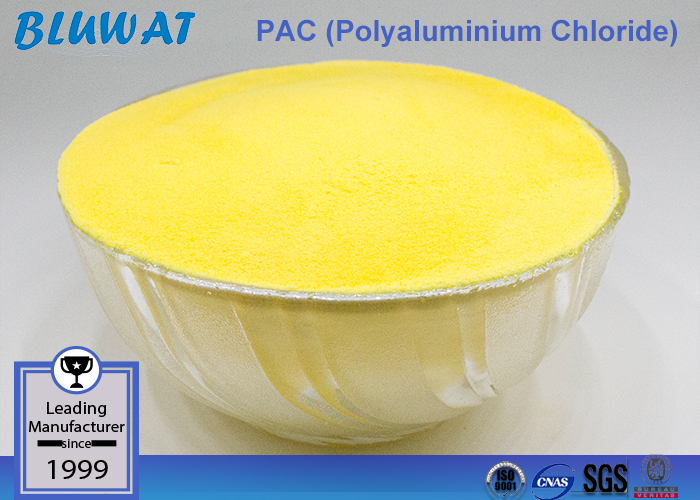| Specifications: | PAC-031 Spray drying type |
| Appearance: | Solid yellow powder |
| Odor: | Odorless |
| Al2O3, % : | ≥30 |
| Basicity ,%: | 70.0~90.0 |
| Insoluble,% : | 1.0 max |
| Specific gravity(@ 25℃) | 1.15-1.20 |
| pH(1% water solution): | 3.5~5.0 |
| Pb %: | <0.006 |
| As %: | <0.001 |
| Advantage |
| 1 | Its purifying effect on low-temperature, low-turbidity and heavily
organic-polluted raw water is much better than other organic
flocculants, furthermore, the treatment cost is lowered by 20%-80%. |
| 2 | It can lead to quick formation of floc (especially at low
temperature) with big size and rapid precipitation service life of
cellular filter of the sedimentation basin. |
| 3 | The dosage is smaller than that of other flocculants, which is
better for improving the quality of treated water. |
| 4 | It has wide-range adaptability to the waters at different
temperatures (in the summer and the winter) and at different
regions (in the south and the north of China). |
| 5 | It is suitable for the automatic dosing device of the alum. |
| 6 | It can adapt to a wide range of pH values (5−9) and can reduce the
pH value and basicity after processing. |
Polyaluminium Chloride Introduction:
PAC-031 is yellow color, spray-drying type powder Polyaluminium
chloride, it is a kind of inorganic polymer coagulant.
The Al2O3 content is more than 30%, basicity is very high around
75-85%, and good coagulation in high turbidity water.
Generally, through compression double, adsorption electrical energy
neutralization, adsorption Bridges, sediment trap, etc system
function, make edema subtle aerosols and colloidal ions off
company, collected, flocculation, coagulation, rainfall to purify
the treatment impact.
Main Properties:
Benefits:
Its purifying effect on low-temperature, low-turbidity and greatly
organic-polluted raw water are better than other organic
flocculants, additionally, the treatment cost is reduced by 20%
-80%.
It can cause the fast development of floc (especially at low
temperature levels) with big size and quick rainfall life span of
cellular filter of the sedimentation basin.
Dosage:
The dosage is smaller than that of other flocculants, which is much
better for improving the quality of treated water.
It has wide-range adaptability to the waters at different
temperatures (in the winter and the summer) and at different areas
(in the south and the north of China).
It is appropriate for automated dosing devices of alum.
It can adjust to a wide variety of pH values (5 − 9) and can
decrease the pH value and basicity after processing.
Application Fields:
Cleansing drinking water and sewage.
Industrial water purification, commercial wastewater, mining, oil
field injection water, metallurgy, coal washing, leather, and all
type of chemical wastewater treatment.
Commercial production: Paper sizing, dye dyeing, printing and
bleaching, medicine, and other fields.
In the artificial coal field, it is used for separating coal and
water with an exceptional result. In the oil refining field, for
oil and water separation.
Application Method:
The user can designate remedy concentration by test and figure out
the optimum dose according to the various to be added after they
are dissolved and diluted.
The dilution ratio of liquid products is 5-50%, and the dilution
ratio of strong items is 2-20%.
The liquid product dosage is 3-40kg/ 1000 lots of water, and the
strong item dosage is 1-15kg/ 1000 heaps of water.
The amount of particular dosing is based on coagulation tests and
experiments.
Packing & Storage:
Powder crammed in 25kg PP woven bags with inner PE bags.
Storied indoors in a dry, aerated, cool location, and do not get
wet.
Life span: 2 years
PAC Usage:
- The user can allocate treatment concentration by test and identify
the optimal dose according to the different to be included after
they are dissolved and watered down.
- The dilution ratio of liquid products is 5-50% and the dilution
ratio of strong products is 2-20%.
- The liquid product dosage is 3-40kg/ 1000 loads water and the
strong item dosage is 1-15kgs in 1000L water.
- The amount of particular dosing is based on coagulation tests and
experiments.

